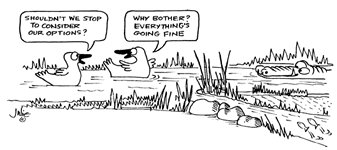Teaching is such a solitary thing. Sure, you’re up in front of a bunch of students, and maybe an instructor if you’re doing course-integrated instruction, but the act still feels solitary. We try to make it less so by seeking feedback from instructors and doing assessment, but we rarely get feedback from people who really understand what we do: our colleagues in the library.
But doing that can be terrifying for some. The idea of showing off your approach to teaching can be intimidating. Many of us assume that whatever our colleagues are doing in the classroom, it’s probably ten times more brilliant than what we are doing. I can guarantee that it’s probably different from what you do, but the fear of finding out they’re so much better at it than you is likely unfounded. You probably do some things they wish they did, and they probably do some things you wish you did. All that will come from discovering this is that you will learn more and become better, which seems worth a bit of anxiety.
As a former head of instruction at two institutions, I’ve guided colleagues through peer learning exercises around their instructional practice. What I’ve learned from doing this at two very different institutions is that there is no one-size-fits-all approach; you have to tailor the approach to the needs, anxieties, and culture of the group. But the value and importance of being able to talk about the good, the bad, and the ugly of teaching with your colleagues cannot be overstated. Not only does it improve your own reflective practice, but it creates a true community of practice, which will elevate everyone’s teaching. A rising tide raises all ships, right?
At one institution, we did peer observation of instruction followed by one-on-one meetings. Before the start of the term, each librarian chose two colleagues whose instruction they would observe (we made sure no one had to work with someone they reported to) and those people, in turn, also observed them. So everyone observed and was observed by two people. We let the observed librarian pick the class they felt most comfortable having observed, which I think is a good way to decrease anxiety. If I could go back, I’d have each librarian first choose two sessions they are comfortable having observed first and then have people choose their observation partners based on scheduling availability, because I know at least one person couldn’t make it to the “ideal” session.
As each pair watched the instruction session, they took notes and wrote down questions they had about the approach the librarian was taking. This was for the one-on-one meeting each pair would have after the session. The idea was not to look for flaws, but to better understand their approach and brainstorm together better ways of meeting their instructional goals. But I think we all found that the act of watching two other people teach was actually far more enlightening than the conversations we had about our own teaching (though they were valuable too). We were able to lift the veil and see other approaches, and the ideas we got from this were incorporated into our future teaching. It worked out really well for all of us.
I will say that the group I did this with was tremendously comfortable with one another. We trusted and relied on each other, and I think that was what made it possible to do this successfully. At an institution where librarians are more anxious about their teaching or simply don’t trust each other enough, the approach might require tweaks. Maybe there is no meeting after the instruction sessions to discuss and reflect on them. Maybe instead, every librarian just observes two other librarians teaching. That, in and of itself, is so valuable. Or maybe your colleagues are just not comfortable letting other librarians watch them teach. These are not concerns to just brush off and ignore. It takes time to build a culture of trust, so if it’s not there yet, you need to find other ways to build a community of practice and ethic of peer learning that get people relying on each other for their learning and instructional improvement. It’s well worth the work.
One way to do this without peer observation is through reflective peer coaching, “a formative model that examines intentions prior to teaching and reflections afterwards” (Vidmar, 2006). We did this several times at one of my places of work and everyone who participated found it really helpful. We adopted the model promoted by our wonderful colleague at Southern Oregon University, Dale Vidmar. If you’re interested in improving teaching and reflective practice, he is a guy to know (or at least read his work!).
So, with reflective peer coaching, librarians pair up and meet once before the individual instruction sessions they want to reflect on are going to be taught. In that first meeting, each librarian talks about the session and their goals for it. They may also discuss concerns or fears that they have about the session, though not everyone will be comfortable with that. Their partner may ask questions to elicit further reflection on their goals and approach, but they are not there to make suggestions.
The pairs do not actually observe the instruction sessions they’ve heard about. Instead, they meet afterwards to discuss how it went. The act of doing this is what really creates a culture of reflective practice. Taking the time to really think about what went well, what didn’t, and how you might improve next time is so valuable. Having to articulate that to someone else, who may be asking probing questions that get you thinking more deeply about the session, leads to even greater learning. I provided each pair with suggested questions (most of which were borrowed from Dale’s work) that they could ask to elicit responses from their partner, but they were free to conduct these conversations however they chose so long as it wasn’t focused on making suggestions to their partner (which is harder to avoid than you might think! We naturally want to offer our help!). In Dale’s model, there is a third person involved, an observer, who makes sure that the pair is focused on reflection and questioning, not suggesting or advising and makes note of any really interesting comments from the person reflecting. Given how busy my colleagues were, we didn’t have observers.
Another way to build a culture of peer learning is through workshopping instruction sessions. This is where a single librarian talks about a session they’ve taught before or are teaching soon with the rest of the instruction librarians or community of practice. Maybe it’s one that is problematic for one reason or another — no computers for the students, big lecture class, instructor asking them to teach ALL THE THINGS, short time-frame, etc. — or it may just be one the librarian wasn’t satisfied with or is anxious about. So they come to their community of practice seeking feedback. How this plays out depends on the time constraints. It can range from simply offering suggestions to collaboratively redesigning the entire session in sub-groups to give the librarian seeking feedback a variety of different approaches to consider. Either way, the focus is on improving the teaching of a single session. While even this can be intimidating, it doesn’t really require laying yourself bare in the same way you would if your colleagues were actually watching you teach. We tried this a few times at our monthly instruction meetings at Portland State and it went pretty well.
Dale Vidmar (2006) writes that “two essential elements to meaningful collaboration and reflection are to create a trusting relationship and to promote thought and inquiry.” But what if you don’t have a community of practice at your place of work? What if there isn’t a culture of trust and the group dynamics are such that trying to create it would be fraught with peril? Well, you can create your own informal community of practice with even just one other colleague. In that case, it’s mainly about having a buddy you trust that you can bounce ideas off of. The value of this cannot be overstated. Even if you are part of a community of practice, I think having a buddy or two (or more) with whom you feel comfortable enough to share your fears and seek help from on a more frequent basis is critical in the workplace. At Portland State, I had my “pocket of wonderful”, a group with whom I was constantly talking about instruction sessions, and who did the same with me. When I created a new tutorial, they always got the first look before I sent things to the larger instruction list. I learned so much from them and feel like I’m a better instructor thanks to the informal conversations we had. At PCC, I was lucky in my first term to have a wonderful colleague who showed me his approaches to teaching certain classes (that I’d be teaching too), warned me about problematic instructors, and gave me valuable feedback. All of my colleagues are completely lovely and helpful, but his support of my instructional practice was invaluable. I hope in the future, I can be of help to him.
We don’t have to struggle alone. Whether you have a single trusted colleague or a large group that meets regularly, you can find ways to build a practice of reflection and peer learning around instruction.
Work Cited
Vidmar, Dale J. 2006. Reflective peer coaching: Crafting collaborative self-assessment in teaching.
Research Strategies 20: 135-148. (you can find a .doc file of this article on Dale’s website)
Photo credit: Reflecting Critically to Improve Action, A Guide for Project M & E







I participated in peer-observations last year at my institution and it was VERY HELPFUL! Granted, my colleagues and I were very close and trusting, so it made the process more relaxing. I learned so much about my own teaching style, but also gained a lot of ideas by watching my fellow librarians. Thanks for this post!